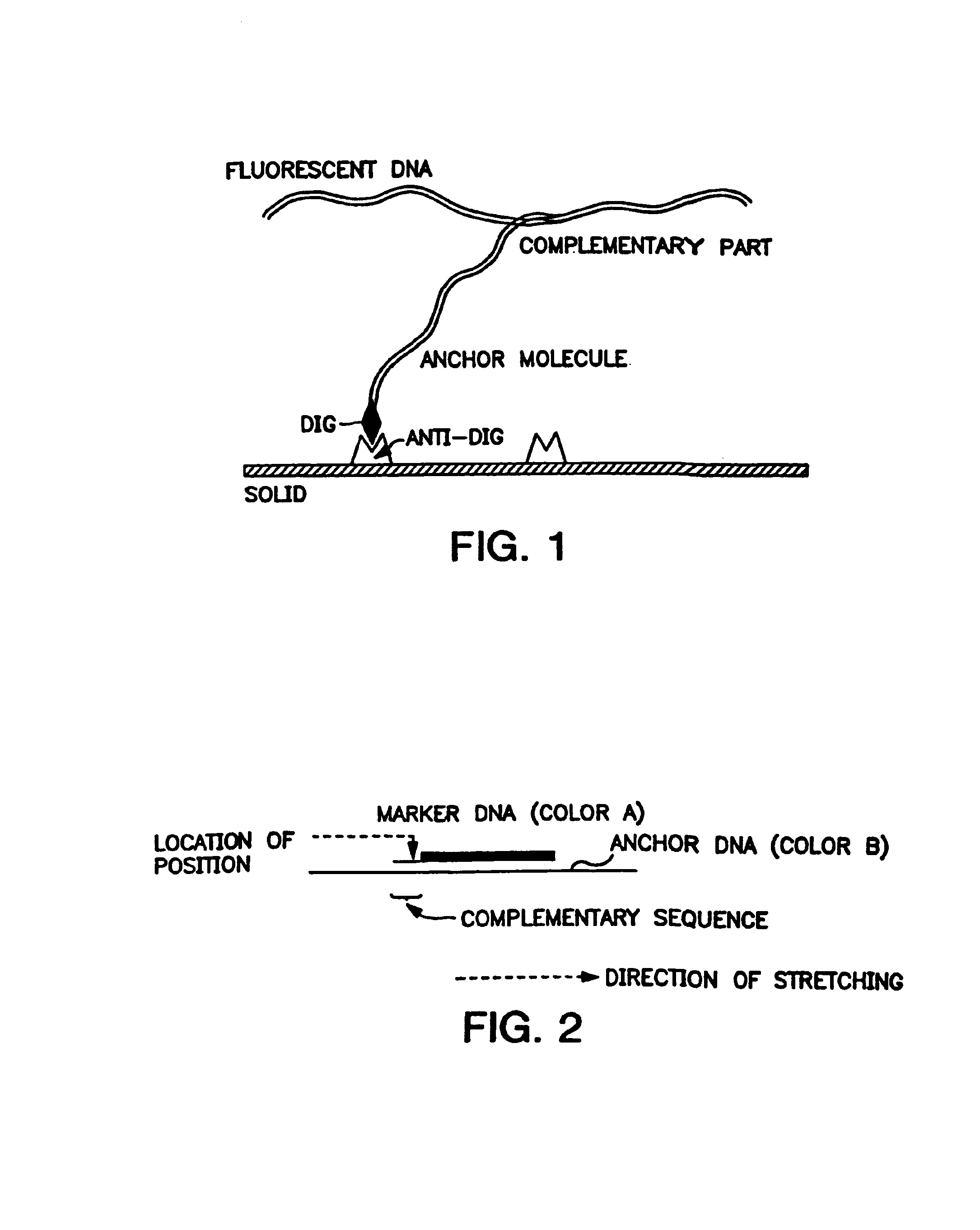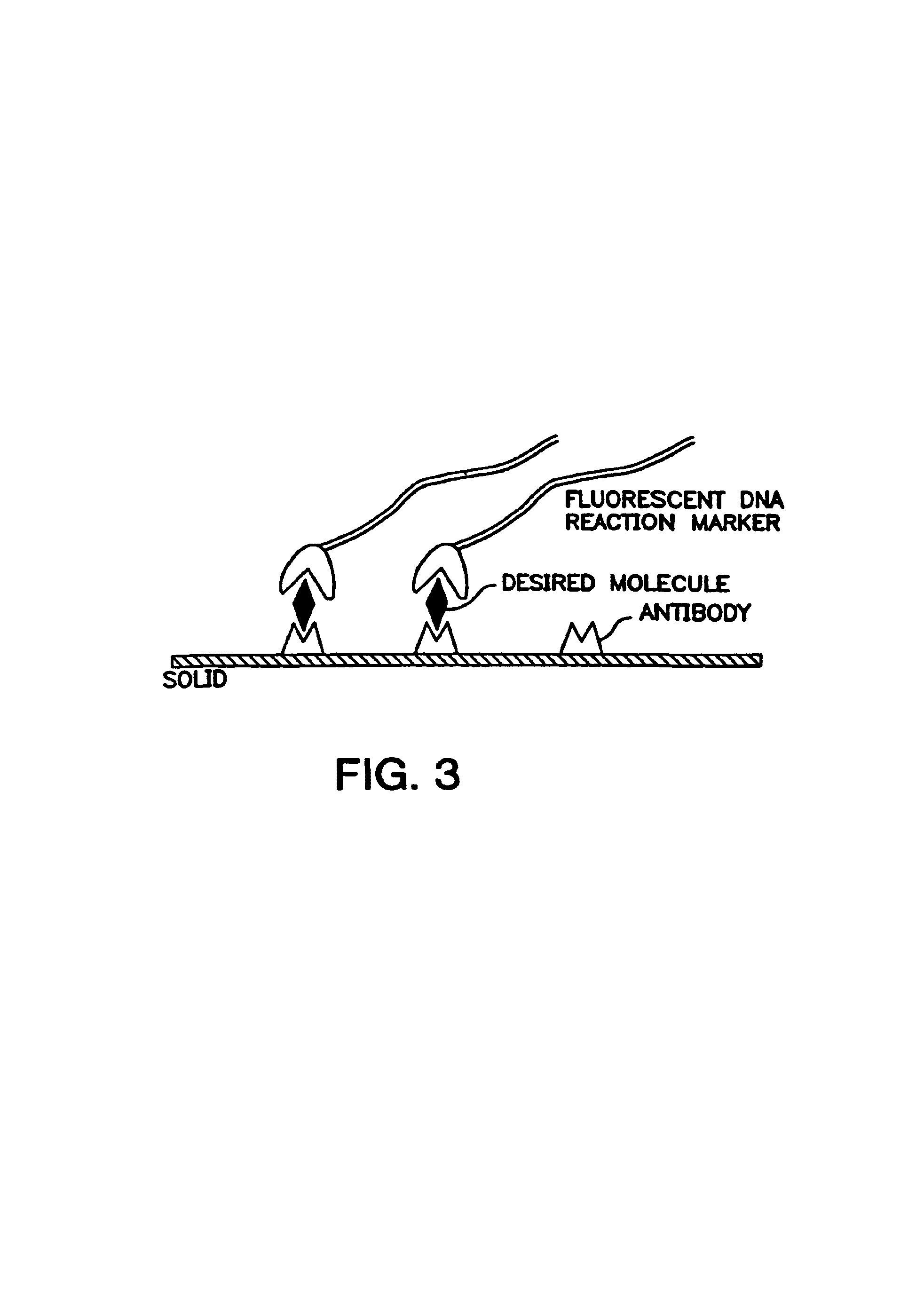Process for aligning macromolecules by passage of a meniscus and applications
a meniscus and macromolecule technology, applied in the field of macromolecule alignment, can solve the problems of limited to one molecule, difficult to carry out by non-qualified staff, and high cost of methods, and achieve the effect of simple and novel
- Summary
- Abstract
- Description
- Claims
- Application Information
AI Technical Summary
Benefits of technology
Problems solved by technology
Method used
Image
Examples
example 1
Materials and Methods
[0208]The λ DNA and the monoclonal antibody (anti-DIG) are obtained from Boehringer-Mannheim. The trichlorosilanes are obtained from Roth-Sochiel. The fluorescent nucleic probes (YOYO1, YOYO3 and POPO1) are obtained from Molecular Probes. The ultraclean glass cover slips are obtained from Erie Scientific ((ESCO) cover slips). The magnetic particles are obtained from Dynal. The microscope is a Diaphot inverted microscope from NIKKON, equipped with a Xenon lamp for epifluorescence and a Hamamatsu intensified CCD camera for the visualization.
Surface Treatment
[0209]Glass cover slips are cleaned for one hour by UV irradiation under an oxygen atmosphere (by formation of ozone). They are then immediately placed in a desiscator previously purged of traces of water by an argon stream. A volume of about 100 to 500 μl of the appropriate trichlorosilane (H2C═CH—(CH2)N—SiCl3)is introduced into the desiccator, from which the surfaces are removed after about 12 hours (n=6) or ...
example 2
Combing of DNA Molecules on Different Surfaces
[0221]The molecular combing of DNA on glass surfaces treated in various ways was observed. Advantage is taken of the difference in absorption between the ends of the molecule and the rest of the molecule. By adsorbing positively charged polymers onto a glass surface, adsorption of negatively charged DNA molecules is enhanced, however, when this charge is large, the DNA molecule is stuck over its entire length and the combing is impossible. However, it is possible to modify the charge of the polymers adsorbed on the glass by modifying the pH conditions, indeed, the positive charges are carried for example by the NH2 groups which pass to the protonated state NH3+ for a pH below the pK of the corresponding base. In basic pH, the charges disappear and the surface no longer attracts DNA. By finely controlling the pH, it was observed that the DNA molecules in solution passed from a state where they are completely stuck to the surface to an int...
example 3
Uniform and Directional Alignment of YAC
[0228]1 μg of YAC previously stained in its agarose plug by means of a YOYO1 fluorescent probe is heated to 68° C., agarased and then diluted in 10 ml of MES (50 mM pH 5.5). Two silanized cover slips (C═C surfaces) are incubated for ≈1.5 h in this solution and then removed at about 170 μm / sec. The YAC molecules are all aligned parallel to the direction of removal of the cover slips (FIG. 9). The integrity of the molecules thus aligned is better than by evaporation after deposition between two cover slips.
Hybridization of a Cosmid with a Combed YAC
[0229]A YAC stained as previously described is anchored on a C═C surface (between two cover slips) and then aligned by the meniscus, during evaporation of the solution. The probes (cosmids) are labeled by incorporation of a biotinylated nucleotide by the random priming technique. The labeled probes (100 ng) and 5 μg of sonicated salmon sperm DNA (≈500 bps) are purified by precipitation in Na-acetate a...
PUM
| Property | Measurement | Unit |
|---|---|---|
| thick | aaaaa | aaaaa |
| pH | aaaaa | aaaaa |
| pH | aaaaa | aaaaa |
Abstract
Description
Claims
Application Information
 Login to View More
Login to View More - R&D
- Intellectual Property
- Life Sciences
- Materials
- Tech Scout
- Unparalleled Data Quality
- Higher Quality Content
- 60% Fewer Hallucinations
Browse by: Latest US Patents, China's latest patents, Technical Efficacy Thesaurus, Application Domain, Technology Topic, Popular Technical Reports.
© 2025 PatSnap. All rights reserved.Legal|Privacy policy|Modern Slavery Act Transparency Statement|Sitemap|About US| Contact US: help@patsnap.com



